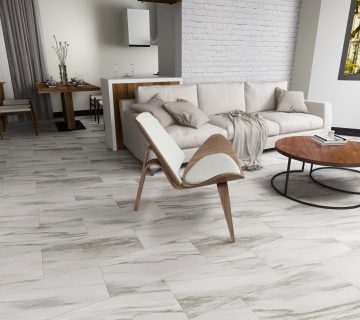There are various products available in the marketplace, as well as numerous installation contractors. An experienced, knowledgeable, professional contractor, who can provide a turn-key installation, should be your starting point.
There are various products available including ESD Epoxy and Polyurethane coatings (for high traffic areas), to Carpet, Rubber, and Vinyl.
ESD Vinyl
The only ESD vinyl floors to consider, are called solid vinyl tile (SVT). It requires plenty of maintenance, but when propertly maintained SVT vinyl is attractive.. The material is relatively inexpensive, but installation and annual maintenance costs can be prohibiitve (at least $1/sq ft per year). This can add up fast..over five years, this adds over $5/ sq ft to the original cost. There are true no-wax ESD vinyl floors, however, they can be costly, and should only be used in very light traffic areas. High speed buffing (burnishing) is often recommended for cleaning, which can get costly (heat from the buffing machine melts and then reseals the floor). An alternative to this is low speed buffing, using a static control spray buff formula. The maintenance cost of SVT conductive tiles is greater than maintaining carpet and rubber.
Static Dissipative Carpet Tile
Carpet tiles are installed with clean, fast-drying release adhesive. The tiles can be installed directly over old VCT or concrete. If you are tired of the maintenance and waxing an SDT dissipative vinyl ESD floor, then carpet tile may be a good choice. Of course, carpet has its disadvantages. Carpet is not well suited to accommodate heavy loads, such as forklifts and pallet jacks. Carpet also has a low resistance to chemicals and solvents.
ESD Rubber
Conductive rubber greatest advantage, is that it is effective at preventing static in areas where grounded footwear is not, or cannot be used-places such as computer labs, command centers, and 911 call centers. (IMPORTANT: you must be sure that the chosen rubber is conductive and not static dissipative; static dissipative rubber floor conductivity exceeds the recommended system resistance (<35 megohms) requirement of ESD S20.20-2007). Ergonomically, rubber has better anti-fatigue factor than epoxy or vinyl; Rubber is less porous than vinyl, which makes it easier to clean, wash and maintain. However, rubber’s installed cost is the highest of all options.
ESD Epoxy
High quality epoxy and urethanes are easy to install, low maintenance, durable, attractive, and cost effective. Solid colors, high gloss, and satin finishes are available. Patterns, multiple colors and textures are even available. An epoxy system must be specified, which will be in compliance with ESD S20.20-2007. This requires resistance to be <35million ohms. Many products on the market do not meet this standard. For explosion proofing, it must be below 1 million ohms. An applicator with suitable experience and knowledge, can ensure that these standards are met. Within facilities where constant heavy loads and high traffic are the norm, epoxies are usually the only practical flooring material. No waxing is required, and low sq ft costs can make this a smart choice. One drawback of epoxy is the lack of color stability. and smooth surface, which can get slippery if wet. Also, when exposed to UV rays, epoxy will tend to amber or yellow. These problems are solved by specifying an epoxy base coat, with a UV stable ESD polyurethane finish coating. This system provide a satin non-slip finish, which with have excellent long term color stability.
Combining Different Materials
In order to accommodate different needs in various departments, you can combine different flooring solutions, for different areas within the facility. You may install conductive carpet tiles in the assembly area then install a perimeter high traffic area of an epoxy conductive flooring system, to handle the majority of the forklift traffic. Another possibility, is to install vinyl tile over access floors and an epoxy product in heavy traffic areas.



